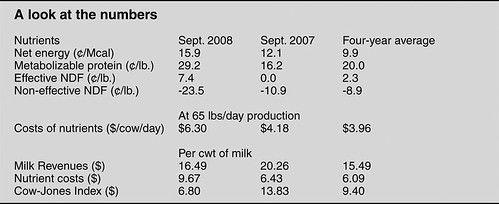I recall just a few months ago when the whole cottonseed market jumped above $250 per ton. I received numerous phone calls and e-mails requesting help on how to deal “with these obscene cottonseed prices.”
I imagine that most dairy producers wouldn’t mind still paying $250 per ton for whole cottonseed. But the rapid changes in feed prices have opened many opportunities for judicious ingredient substitutions in dairy diets.
There are bargains out there, but the ride is getting wilder by the minute.
Tracking
For many months, I have been writing a column in the Ohio State Extension dairy newsletter, Buckeye Dairy News, about feed costs evaluation (http://dairy.osu.edu).
To do this, I use a software that was developed here at Ohio State, SESAME. With this software, one can estimate the cost of all important nutrients in a feed and, thus, compare feeds on an equal footing.
Our research has shown that the cost of dietary energy — expressed as net energy for lactation (in Mcal per pound); metabolizable protein (in pounds), which is the sum of the digestible microbial protein produced in the rumen plus the digestible feed protein that escapes breakdown in the rumen (the so-called bypass protein or rumen undegradable protein); effective fiber (in pounds), the kind that cows much chew on, also called effective NDF; and the non-effective fiber (also in pounds) — account for nearly all the costs of feeding a dairy cow.
The numbers
Check the accompanying table, where I present the current costs of these nutrients and compare these costs to what they were 12 months ago, and their four-year averages.
With the exception of non-effective NDF, one can easily gauge the substantial increases that have occurred across all important nutrients fed to dairy cows.
Currently the cost of dietary energy is 61 percent greater and the cost of metabolizable protein is 46 percent greater than their respective four-year averages.
Consequently, the daily cost of providing the four important nutrients to a cow producing 65 pounds per day has increased by 59 percent, or $2.34 per cow per day.
It gets worse. The situation gets even worse when one looks at revenues and costs per hundredweight of milk.
Although our current base milk price is about $1 per hundredweight better than the four-year average, the cost of feeding a cow has gone up by over $3.50 per day.
What is left to pay for everything else (including family living expenses) — what I have call the Cow-Jones Index — has now dropped to $6.80 per hundredweight, a figure that is half what we had last September, and barely 70 percent of what we have averaged over the last four years.
Cow-Jones Index
The tilting point for the Cow-Jones is at about $8 per hundredweight. Under $8, and most dairy producers start losing money.
The index now stands at $1.20 per hundredweight under this benchmark — the third month in a row that this has occurred.
We have to go all the way back to March 2006 to find a similar pattern. As most of you will recall, the period from March 2006 through November 2006 was devastating to most dairy producers — arguably the worst nine months in the whole history of dairying in this country.
Hopefully, the pattern will not repeat and milk prices will stop falling and feed prices will ease down. There are already some strong signs that feed prices are going through a strong correction.
Regardless, margins will be very tight in the foreseeable future, so manage wisely.
STAY INFORMED. SIGN UP!
Up-to-date agriculture news in your inbox!













